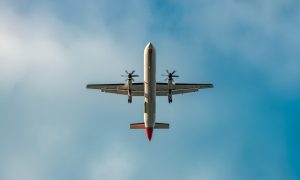
Propellers play an important role in modern aviation. Consisting of a central hub with multiple branching blades, they are used to produce thrust. Some airplanes use jet engines to produce thrust, whereas others use propellers.
When compared to jet engines, propellers are often preferred for smaller airplanes because they are more efficient. Both jet engines and propellers burn kerosene-based fuel, such as Jet A or Jet A-1. Propellers, however, are more efficient at slower speeds and lower altitudes, making them ideal for smaller airplanes. Even if you’ve flown on a propeller-driven airplane, though, you might be wondering how exactly they produce thrust.
Turboprop Engines
Propellers produce thrust with the help of a gas turbine engine. Known as a turboprop, it burns a mixture of fuel and air. Turboprops have an air intake, which sucks in air from outside the airplane. The air is mixed with fuel in the combustion chamber. Once ignited, the mixture produces combustion gases that turn the engine’s turbine.
At the end of the turbine is the propeller. As the turbine turns, so will the propeller. Propeller aircraft leverage these specialized gas turbine engines to produce thrust.
Curved Shape
If you’ve ever inspected a propeller up close, you may recall that the blades aren’t entirely flat. Rather, they are curved. They have an angular top surface that allows them to cut through the air — similar to how an airplane’s wings cut through the air.
With their curved shape, propellers are able to redirect airflow. They essentially push air backward. Newton’s third law of motion states that for every action, there is an equal and opposite reaction. When a propeller pushes air backward, it creates an equal opposing force, which propels the aircraft forward.
Exhaust
Propeller-driven airplanes still produce some thrust from exhaust. Exhaust consists of hot combustion gases. When expelled, these exhaust gases propel the airplane forward.
Jet engines, such as turbofans, produce most of their thrust from exhaust. However, even turboprops produce some of their thrust from exhaust.
Most of the energy generated from the combustion process of a turboprop is used on the gearbox, but about 10% of it goes to the exhaust. These exhaust gases assist the propeller by helping to produce thrust.
In Conclusion
Propellers remain a vital piece of aviation technology. By combining the power of turboprop engines, they transform combustion energy into forward thrust. While jet engines dominate commercial aviation, propeller-driven aircraft continue to serve an important role in regional travel, cargo flights and general aviation.



